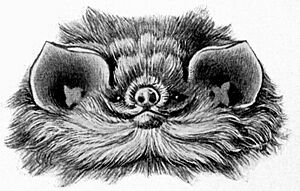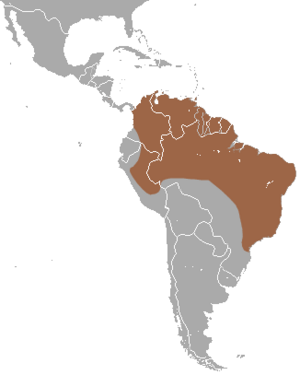Thumbless bat facts for kids
Quick facts for kids Thumbless Bat |
|
|---|---|
 |
|
| Conservation status | |
| Scientific classification | |
| Genus: |
Furipterus
|
| Species: |
horrens
|
 |
|
The thumbless bat (Furipterus horrens) is a small bat that eats insects. It is part of a special family of bats called Furipteridae. These bats get their name because their tiny thumbs are hidden inside their wing membranes. This makes them look like they don't have thumbs at all!
About the Thumbless Bat
The thumbless bat is a unique type of mammal. It belongs to a group of bats called Chiroptera. There are only two main groups, or genera, in its family. These are Amorphochilus and Furipterus. Each of these groups contains only one species.
A scientist named Frédéric Cuvier first described this bat in 1828. He gave it the name Furia. Later, in 1839, another scientist, Charles Bonaparte, changed its name to Furipterus.
Where Thumbless Bats Live
You can find the thumbless bat in parts of Central and South America. Its home range includes countries like Costa Rica and Panama. It also lives in southern Brazil and Bolivia. Other places where it has been seen are Venezuela, Colombia, and Ecuador. You can also find it in Suriname, French Guiana, Guyana, Trinidad, and Peru.
In Brazil, these bats have been found in many different areas. This includes the Amazon rainforest and other important natural regions.
Thumbless Bat Habits
Thumbless bats are not very common. However, they are found across a wide area. Male and female bats sometimes live apart during certain times of the year. Scientists have found more than 60 male bats living together in one hollow space.
These bats fly around to catch their food. They mostly eat insects. They are known as "aerial insectivores" because they catch insects while flying.
Thumbless bats often live in caves. They also like places that are moist or damp. They are often found near large lakes. This moist environment is very important for bats that catch insects in the air. However, they are even more active in forests than near lakes. They usually roost, or rest, in small groups. These groups can have up to 60 bats. They often find deep cracks in rocks inside caves to make their homes.


